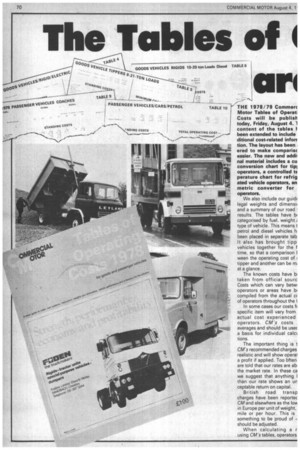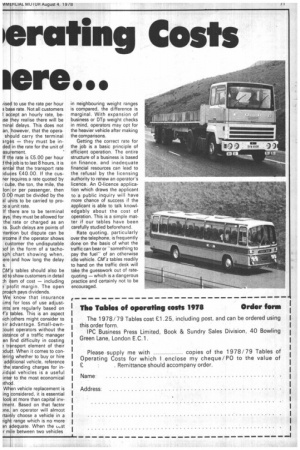The Tables of I an lorating Costs ere...
Page 72

Page 73

If you've noticed an error in this article please click here to report it so we can fix it.
THE 978/79 Commerc Motor Tables of Operat Costs will be publish today, Friday. August 4. 1 content of the tables been extended to include ditional cost-related inforr tion. The layout has been ered to make comparisc easier. The new and addil nal material includes a cu conversion chart for tipi operators, a controlled te perature chart for refrig ated vehicle operators, an metric converter for operators.
We also include our guich legal weights and dimensh and a summary of our road • results. The tables have bi categorised by fuel, weight type of vehicle. This means petrol and diesel vehicles h been placed in separate tab It also has brought tipp vehicles together for the f time, so that a comparison I ween the operating cost of tipper and another can be rn. at a glance.
The known costs have bl taken from official sourc Costs which can vary betwl operators or areas have bi compiled from the actual cc of operators throughout the
In some cases our costs f( specific item will vary from actual cost experienced operators CM's costs averages and should be usec a basis for individual calci tions.
The important thing is t CM's recommended charges realistic and will show operai a profit if applied. Too bften are told that our rates are ab, the market rate. In these ca we suggest that anything I than our rate shows an Lir ceptable return on capital.
British road transp charges have been reportec CM and elsewhere as the lovs in Europe per unit of weight, mile or per hour. This is something to be proud of should be adjusted.
When calculating a r using CM's tables, operators
rise 3 ba I a ise nin an, sh 3rg ded asu If if th ent )du ler cu Ion 0.0 al u a If t ays the ra. Tten ?rc cu )of 3ph 'ere
S.
CM 3c1 t p pro We iim ints iich 3i r ou en tr ing loo tme rtai ugh an r m Ito use the rate per hour e rate. Not all customers ept an hourly rate, behey realise there will be 1 delays. This does not however, that the operauld carry the terminal s — they must be inin the rate for the unit of ement.
e rate is £5.00 per hour job is to last 8 hours, it is al that the transport rate es £40.00. If the cusequires, a rate quoted by e, the ton, the mile, the or per passenger, then must be divided by the its to be carried to prounit rate.
ere are to be terminal they must be allowed for rate or charged as an uch delays are points of ion but dispute can be e if the operator shows tomer the undisputable in the form of a tachochart showing when, and how long the delay s tables should also be show customers in detail em of cost — including ofit margin. The open ch pays dividends.
know that insurance for loss of use adjustare regularly based on ables This is an aspect others might consider to dvantage. Small-own t operators without the nce of a traffic manager ind difficulty in costing nsport element of their t. When it comes to cong whether to buy or hire itional vehicle, reference standing charges for inal vehicles is a useful to the most economical en vehicle replacement is considered, it is essential at more than capital invt. Based on that factor an operator will almost ly choose a vehicle in a range which is no more dequate. When the Lust le between two vehicles in neighbouring weight ranges is compared, the difference is marginal. With expansion of business or DTp weight checks in mind, operators may opt for the heavier vehicle after making the comparisons.
Getting the correct rate for the job is a basic principle of efficient operation. The entire structure of a business is based on finance, and inadequate financial resources can lead to the refusal by the licensing authority to renew an operator's licence. An 0-licence application which draws the applicant to a public inquiry will have more chance of success if the applicant is able to talk knowledgably about the cost of operation. This is a simple matter if our tables have been carefully studied beforehand.
Rate quoting, particularly over the telephone, is frequently done on the basis of what the traffic can bear or ''something to pay the fuelof an otherwise idle vehicle. CM's tables readily to hand on the traffic desk will take the guesswork out of ratequoting — which is a dangerous practice and certainly not to be encouraged.




















































































































